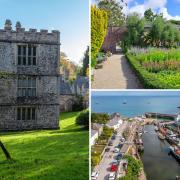In our May issue, we take a look at toy soldiers and figures, and in particular at the firm of Britains. William Britain started producing hollow-cast toy soldiers in 1893 and set up his company when Queen Victoria reigned.
Martin McIlroy, Head of Bearne's Collectors' Department, takes a look at toy soldiers and figures, and in particular at the firm of Britains
William Britain started producing hollow-cast toy soldiers in 1893 and set up his company, Britains. At the time, Queen Victoria was on the throne, ruling over territories that stretched over four continents around the world. This, combined with the tremendous traditions within the regiments of the British Army, with their standards, mascots, battle honours and different uniforms, proved to be a gold mine for William Britain.
Up until the 1890s, the Germans and French had dominated the toy market. Firms like Mignot and Heyde produced toy soldiers, which were imported in their thousands. But these were solid figures and William Britain took them on with his hollow-cast figures, which were cheaper to produce. They were an instant success and the firm of Britains never looked back.
The figures were all hand-painted, and as a general rule cavalry figures came in a box containing five figures, an officer (or bugler) and four troopers. Infantry figures came in a box with eight figures, an officer and seven other ranks. Early foot figures were cast with oval bases but were later changed to square bases. So, as a general rule of thumb, oval-based figures are earlier than their square-based counterparts.
Inside each box was a piece of card called an insert, which had small holes punched in it. The figures were tied down to the card and because they could not slide around inside the box their paintwork would not be chipped. To collectors it is very important that this card insert is still with the box and figures, greatly increasing the set's value.
The boxes themselves were miniature works of art, normally in either British tunic scarlet or navy-blue. Each box lid had a printed paper label giving the set number and a description of the contents. The labels often gave the battle honours of the regiment depicted inside - 'Waterloo', 'Inkerman', 'Halma', Sudan'- enough to stir any boy's blood.
Along with the battle honours, there was the regimental motto and, of course, a rousing line drawing of one of the figures, such as a charging lancer or a dashing Hussar. Fred Whisstock was one of the artists of the labels who joined Britains at the end of the First World War. His signature appears on the label and a set with a Whisstock box is much more sought after than the same set in a non-Whisstock box.
Britains reflected the changes in the British Army from the Zulu campaigns, fought in traditional scarlet uniforms and dark blue trousers, through to the Boer War when khaki was introduced, but right the way through to the First World War and the introduction of gas masks. Models of transport also evolved from mule trains to horse-drawn artillery, supply wagons and ambulances, right up to the introduction of the staff car and, of course, the tank.
Britains didn't just concentrate on the British Army, however. When a boy set out his soldiers on the floor he needed an enemy and Britains didn't disappoint. There were Zulus, Boxers (Chinese infantry), Togoland warriors, Boer infantry and cavalry, and many others. With an eye on the export market, sets were also produced for most of the major countries including America, France, Argentina, Russia, Sweden and numerous others.
The First World War brought about many changes within Britains' figures. Firstly, gone were the scarlet uniforms and in came khaki; secondly, mechanised warfare and the machine gun meant that cavalry was now obsolete; and thirdly, and most significantly, the mood of the public had turned against war and armies.
The carnage of those four years and the tremendous loss of life meant sales of toy soldiers fell and Britains had to look for new ideas. The answer came with their 'Home Series' products, which ranged from their farmyard series to their garden series. These products proved just as popular as the soldiers had and were produced in metal until the late 1960s when plastic was used.
In the Farm Series they even produced a figure called the 'village idiot' - not very PC in this day and age - and this figure is one of the most collectable individual figures that Britains produced. Football teams, horse racing colours, even boy scouts were also modelled.
Britains carried on producing sets based on the Empire until the 1960s, and later Commonwealth troops, possibly typified by the Bahamas Police Band (Set No 2184). Plastic took over from metal and the number of different sets produced declined. It was not until the 'Collectors' Series' was brought out in the early 1980s that metal was used again and the Edwardian regiments were reproduced.
Returning to the present day, Britains has moved its production to China, and for the past few years has been producing Collectors' Sets, Limited Edition figures and special Collectors' Series. The company has re-visited its back catalogues and produced a range of figures reflecting British past glory, as well as other regiments. The Indian Army range reflects the glory days of the British Raj. Other historic events include the Charge of the Light Brigade, Waterloo, Rorke's Drift, World War I and D-Day.
Still beautifully packaged in traditional Britains style, these sets come in maroon boxes with printed paper labels on the lids giving the battle honours of the regiment inside the box, each figure tied down to the yellow card insert - no change there then!
But as a traditional auctioneer, give me pre-1960s Britains' figures every time. These are the true 'collectable' figures. Anyone investing in the new generation of Britains' figures must take a long-term view if purchased as an investment. Limited Edition or Collectors' Series they might be, but only time will tell if they are as good as their earlier counterparts.


























